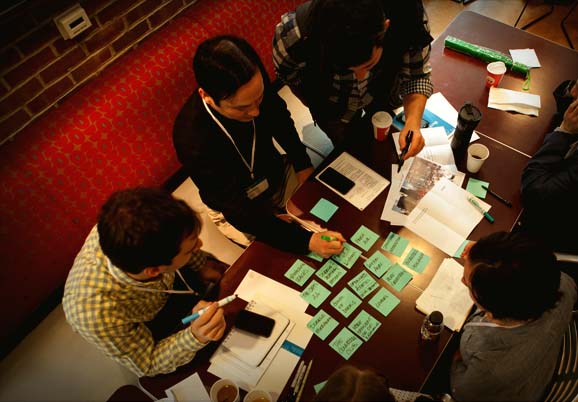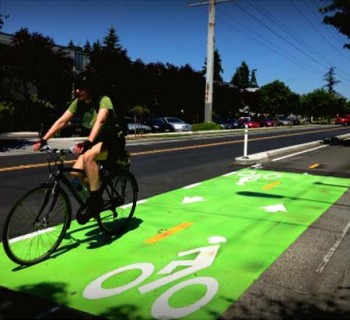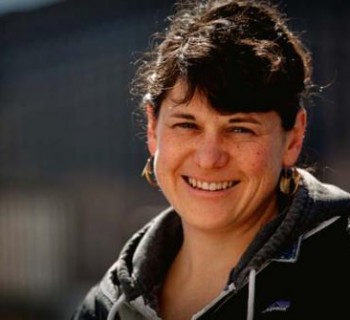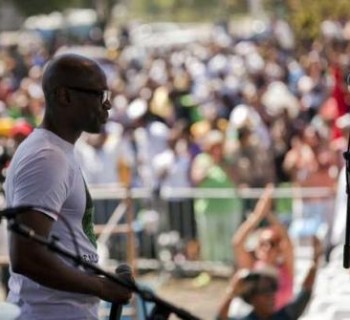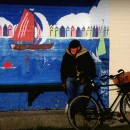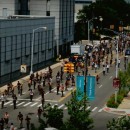DETROIT—After long hours listening to lectures and participating in breakout groups of the Project for Public Spaces Leadership Council in Detroit April 11 - 12, almost 300 people from international destinations chatted endlessly about their own ideas and connections during happy hour at the Madison Building, and took in ideas and art later at the Museum of Contemporary Art in Detroit.
Guests munched on veggies and hummus in clever little Altoids boxes, chicken satay on sticks, crab cakes and dim sum along with assorted wines and soda pop.
Luke Peligrin shopped for potential funders as he sipped a beer. A veteran of several Burning Man events in Nevada, he hopes to create an artisan city within Detroit at Historic Fort Wayne during Movement this Memorial Weekend.
“Imagine a marriage of art and science, a way to think of this great, 88-acre space differently,” Peligrinis said of his dream project, “We Came in Peace.”
“Placemaking,” was right down his alley, he said. Guest speakers from around the world, funded by the Knight Foundation, the Kresge Foundation and Rock Ventures, sought to understand the architecture of place, the combination of historic preservation of buildings with the sheer fun and creativity of helping people thrive in these areas.
He divides his time between the SoHo district of New York and the city of Detroit. He hopes to gain a $300,000 budget for his dream venture, detailed on his website, www.DetroitEd.org. “We’ll bring the energy of Burning Man to Detroit, restore a beautiful site.”
Among other plans, local and international artists will compete in “Secret Walls,” in an art battle in front of a live audience, using Fort Wayne, a site built to protect Detroit during the War of 1812. Murals created that day, according to Peligrins, will be auctioned and proceeds going to organizations that support the art extravaganza. He hopes these groups will fund shuttles going back and forth from Hart Plaza and Fort Wayne, with revelers from the techno festival.
If his idea was ambitious, Lorraine Girvan of Toronto, spoke of compassion. She hopes to use some of the tools of placemaking, what she called simple, elegant ways to make places more interesting, and bring it to low income communities. “Toronto is a global, multicultural town that seeks to support its diverse population,” Girvan said.
Earlier in March, Dan Gilbert, the CEO of Quicken Loans, laid out a master plan for bringing thousands of people downtown to saunter the streets, shop at new retail and live in the constellation of skyscrapers. During Happy Hour, John Marcicky, led several tours through the five-story M@dison Building, a man so energized by the building he literally leapt up five flights of steps and encouraged others to follow.
Up on the roof, equipped with a bar, a set of innovative chairs and an elevator for the less athletic, he showed off Campus Martius, the first installation that brought people from various buildings to a grass and concrete park to listen to jazz in the summer and ice skate in winter.
Visitors stood in wonder as Marcicky took them to the floors housing various companies, Bizdom, Doodle Home and Detroit Labs, working past 5 o’clock because they believed in what their companies were doing. He said his boss, Dan Gilbert’s vision is to help many people stay downtown by providing a rent subsidy on the now fully rented Broderick Towers and other buildings.
Jeff Peele, a part time organizer of the Placemaking Conference who lives in New York City and attends Hunter College, said he had a powerful weekend. “We’re part of building a great movement. More cities are coming alive and we can shape and mold places of interest,” he said.
As people trooped out of the building, they boarded shuttle buses for MOCAD, a building which languished more than 20 years and now is the epicenter for edgy art and conversations about urban activism. Here conference attendees listened to a panel of innovators coordinated by the Urban Innovative Exchange. This included a slide show of people making an impact on Detroit put together by Marvin Shaouni.
They heard from a panel including Erik Howard, founder of the Alley Project in south west Detroit, Kate Daughdrill, innovative artist who founded the Edible Hut on the east side, George N’Namdi, owner of the N’Namdi Gallery who coordinated grants, donations and a for-profit art program to build up the Sugar Hill district in Midtown.
Among the speakers, panelists showed photographs of ways to engage children and adults in making art, planting vegetables and playing games. One spoke of being a coordinator as much as an artist in engaging others in your vision.
“You can feel the energy these newcomers bring to Detroit, it is contagious,” said Ann Marie D’Anna, an artist and resident of the Boston Edison community.


